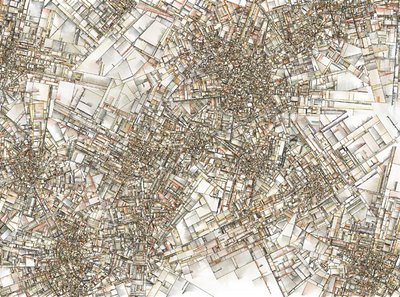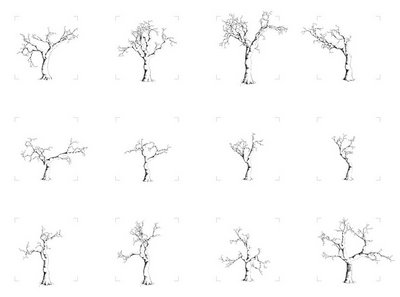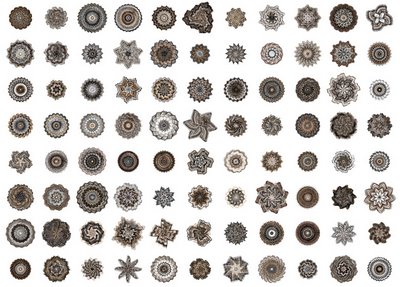Algorithmic urbanist
These were all drawn by a computer, using code by Jared Tarbell.

The above image – called Substrate – is only one stage in a long algorithmic process. The various versions morph through different, oddly city-like fractal patterns, forming boulevards, squares, medinas – and reminding me of central Fes.
A few intermediary steps:



And some square ones:


All of which leaves me to wonder if the Artificially Intelligent city of the future will constantly reprogram itself, forming new wards and clusters where there had only been streets before – only to back-track, erupting fungus-like in bursts of self-assembled geometry. Weird overlaps and elisions. Symmetrical superslums.
Alternatively, you could create a videogame that reprograms itself as it's played – forming new and unique levels, none of which ever repeats itself – and the maps you try to make... look like these.
Meanwhile, Tarbell's algorithms also produce more organic forms:


[Note: It's worth clicking on the sand dollars and scrolling down].
So if algorithms ever broke into a genetic lab – what might crawl out the next day?
Finally, there's this beautifully tangled, gravitationally avant-garde quasi-planet, like someting out of a sci-fi novelist's wet dream. An anti-earth re-seamed together forming monstrous rings and topographies:


And there's more on Tarbell's website.
(Via Drawn – with huge thanks to Brent Kissel!).

The above image – called Substrate – is only one stage in a long algorithmic process. The various versions morph through different, oddly city-like fractal patterns, forming boulevards, squares, medinas – and reminding me of central Fes.
A few intermediary steps:



And some square ones:


All of which leaves me to wonder if the Artificially Intelligent city of the future will constantly reprogram itself, forming new wards and clusters where there had only been streets before – only to back-track, erupting fungus-like in bursts of self-assembled geometry. Weird overlaps and elisions. Symmetrical superslums.
Alternatively, you could create a videogame that reprograms itself as it's played – forming new and unique levels, none of which ever repeats itself – and the maps you try to make... look like these.
Meanwhile, Tarbell's algorithms also produce more organic forms:


[Note: It's worth clicking on the sand dollars and scrolling down].
So if algorithms ever broke into a genetic lab – what might crawl out the next day?
Finally, there's this beautifully tangled, gravitationally avant-garde quasi-planet, like someting out of a sci-fi novelist's wet dream. An anti-earth re-seamed together forming monstrous rings and topographies:


And there's more on Tarbell's website.
(Via Drawn – with huge thanks to Brent Kissel!).





Comments are moderated.
If it's not spam, it will appear here shortly!
MacOS and *nix users can get substrate as part of jwz's xscreensaver. I've used it as one of mine for a while, and I still stare at it as it draws.
http://jwz.org/xscreensaver/
last image reminds me of a Crucifixion by Francis Bacon, if such a thing exists
Indeed - I'd like to see his Ascension.
Why do you keep switching back to partial feeds?! Full feeds, please!
If you built a new town or PUD using those fractal patterns as your streets and blocks, would the city be more inhabitable or less? Would it take on the character of a medieval city, formed by centuries of accretion, or be simply a more chaotic Seaside? Would it thrive or be dull?
Hey Roland - It's nothing I'm doing on my end, but I do apologize for the inconvenience. I'll see if there's any way to fix that, but I'm not doing anything different between posts. Well - as far as Blogger goes, that is. I do do different things...
But I'll see what I can do. Otherwise, the site itself - BLDGBLOG itself - seems to be working alright, if you can stop by now and again to catch the working end of any broken feeds. But thanks for pointing it out -
Post a Comment